
The Growing Threat of Space Debris: Impacts on Satellites, Space Exploration, and Mitigation Strategies
– PikeOS, SpaceIntroduction: The Age of Satellites and Space Exploration
The exploration and utilization of outer space represent some of humanity's most significant scientific achievements. Since the launch of the first artificial satellite, Sputnik, in 1957, thousands of satellites have been placed into orbit around the Earth for purposes ranging from communication and navigation to Earth observation and scientific research. These satellites play an essential role in modern life, powering global telecommunications, GPS systems, weather monitoring, and environmental studies. With the exponential growth of space activities, the number of objects in orbit has dramatically increased, creating a new, pressing challenge for spacefaring nations: Space debris, also known as orbital debris or "space junk".
Space right now is becoming increasingly crowded. There are thousands of active satellites orbiting the Earth, and this number continues to rise, driven by the expansion of commercial space industries and governmental space initiatives. However, these active satellites represent only a fraction of the total objects in space. Thousands of defunct satellites, spent rocket stages, and fragments from previous collisions or satellite disintegrations orbit our planet. This growing collection of debris poses a serious threat to active satellites, space missions, and even future space exploration. The risk of collision with these high-speed debris objects is becoming a significant concern for the global space community.
The Growing Threat of Space Debris
Space Debris: Definition and Causes
Space debris consists of non-functional human-made objects that remain in Earth's orbit. These can include defunct satellites, used rocket stages, fragments from spacecraft collisions, exploded fuel tanks, and even lost tools from spacewalks. Space debris can be found in various orbits, including Low Earth Orbit (LEO - between 160 to 2,000 km), Medium Earth Orbit (MEO - between 2,000 and 35,786 km), and Geostationary Orbit (GEO - 35,786 km and more). However, the highest concentration of debris is in LEO, where many communication and Earth observation satellites operate.
The debris travels at extremely high speeds - up to 28,000 kilometers per hour - making even small fragments dangerous. For instance, a paint chip only a few millimeters wide can puncture the protective shielding of a satellite or spacecraft due to the immense kinetic energy at such speeds.
The primary causes of space debris include:
- Satellite Malfunctions and End of Life: Once a satellite has completed its operational life or malfunctions, it remains in orbit unless deliberately de-orbited. Without a propulsion system or active control, the satellite turns into debris.
- Rocket Stages and Launch Vehicles: After deploying their payload, many launch vehicles leave spent rocket stages in orbit. These large objects can remain in orbit for years or even decades, contributing to the debris problem.
- Explosions and Collisions: Explosions of rocket stages due to leftover fuel or pressurized tanks, as well as accidental collisions between satellites, have created large amounts of debris. A collision between a defunct satellite and an active communication satellite can produce thousands of debris fragments.
- Anti-Satellite Weapon Tests (ASAT): Intentional destruction of satellites, where a missile destroyes an old weather satellite, can generate an enormous amount of debris. The resulting fragments spread into various orbits, increasing the risk of collisions with operational spacecraft.
The Kessler Syndrome: A Cascade of Collisions
One of the most concerning scenarios regarding space debris is the Kessler Syndrome, a theory proposed by NASA scientist Donald J. Kessler in 1978. The Kessler Syndrome refers to a self-perpetuating cascade of collisions, where one collision between satellites or debris creates more debris, which in turn leads to more collisions. As the number of debris objects increases, so does the likelihood of further collisions. In the worst-case scenario, the density of debris could reach a point where entire regions of orbit become unusable, effectively trapping any new spacecraft from safely operating in those orbits.
The Kessler Syndrome presents a serious threat to space exploration, especially in low Earth orbit. The International Space Station (ISS), as well as many scientific, military, and commercial satellites, would face an exponentially increasing risk of collision. This cascading effect could severely limit humanity's access to space and curtail the benefits that satellites provide to life on Earth.
Solutions and Mitigation Strategies
Active Debris Removal (ADR)
Active Debris Removal (ADR) is a set of technologies and techniques designed to capture and remove large debris objects from orbit. ADR aims to prevent collisions between large pieces of debris, which are more likely to generate additional fragments. Various ADR methods are currently under development, including:
- Robotic Capture: Using robotic arms or nets to capture debris and move it to a lower orbit, where it will eventually re-enter the atmosphere and burn up. For example, the European Space Agency (ESA) is working on a mission called ClearSpace-1, which will use a robotic arm to capture a defunct satellite and guide it to a controlled re-entry.
- Tether Technologies: Some concepts involve attaching tethers to debris objects to slow them down, causing them to de-orbit and burn up in the atmosphere. These tethers use atmospheric drag or electromagnetic forces to reduce the velocity of the debris.
- Harpoons and Lasers: Another potential solution is using harpoons or lasers to target debris. Harpoons could physically capture debris, while lasers could ablate the surface of debris objects, changing their trajectory and causing them to re-enter the atmosphere.
End-of-Life Strategies for Satellites
One of the most effective ways to reduce space debris is to ensure that satellites are properly de-orbited at the end of their operational life. This can be done by:
- Controlled De-orbiting: Satellites equipped with propulsion systems can perform controlled de-orbiting maneuvers, guiding themselves into the Earth's atmosphere to burn up upon re-entry. This requires careful planning and fuel management throughout the satellite's mission to ensure enough fuel remains for the de-orbiting process.
- Graveyard Orbits: For satellites in higher orbits, such as geostationary orbit, de-orbiting may not be feasible. In these cases, satellites can be moved to "graveyard orbits" at the end of their operational life. These orbits are farther from the Earth and have a lower risk of interfering with active satellites.
- Passivation: Passivation involves disabling all energy sources, such as batteries or fuel, in defunct satellites to prevent explosions. Explosions are a significant source of debris, so passivation reduces the likelihood of future debris generation.
Real-Time Operating Systems for Spacecraft
Real-time operating systems (RTOS) can play a crucial role in the operation of satellites and spacecraft. Systems like PikeOS from SYSGO provide deterministic performance, ensuring that critical tasks are executed on time. In the context of space debris mitigation, the RTOS can help satellites and spacecraft respond to potential collisions by enabling real-time decision-making and maneuvering.
- Collision Avoidance: RTOS can process data from ground-based tracking systems or onboard sensors to detect potential collision risks in real-time. When an impending collision is detected, the RTOS can promptly initiate avoidance maneuvers, adjusting the spacecraft's trajectory or altitude to avoid debris. These fast and autonomous responses are particularly important for satellites operating in debris-laden low Earth orbit (LEO).
- Autonomous Navigation: RTOS also supports autonomous navigation capabilities, enabling spacecraft to make real-time adjustments to their orbits without the need for continuous ground-based intervention. This autonomy is especially beneficial for managing large satellite constellations, where the sheer number of satellites demands distributed, real-time control to maintain safe operations.
- RTOS in Space Missions: RTOS like PikeOS are commonly used in space missions. For example, PikeOS by SYSGO, is employed in various aerospace applications for its robust safety and real-time processing features. PikeOS is a notable RTOS that supports high levels of reliability and security, making it suitable for mission-critical tasks in both civilian and military space missions.
SYSGO’s PikeOS, in particular, is designed with partitioning features that enable safe separation of critical tasks, such as collision avoidance maneuvers, from other non-essential processes. This partitioning enhances system resilience and minimizes the risk of interference among onboard systems, ensuring that critical tasks are prioritized and executed reliably. These RTOS can be crucial components in the technological toolkit needed to manage the risks of space debris, helping to ensure the long-term sustainability and safety of space operations.
Future Risks and Challenges
Exponential Growth of Space Traffic
The rapid expansion of space activities, particularly in the commercial sector, is contributing to an increasingly crowded orbital environment. Companies like SpaceX, Amazon's Project Kuiper, and OneWeb are launching large constellations of small satellites into low Earth orbit to provide global internet coverage. These "mega-constellations" consist of thousands of satellites, dramatically increasing the number of objects in orbit. While these initiatives offer significant benefits for global communication, they also increase the likelihood of collisions and contribute to the space debris problem.
The sheer volume of space traffic complicates the task of tracking and managing debris. Space surveillance networks, such as the U.S. Space Surveillance Network (SSN), can track objects down to about 10 centimeters in size. However, smaller debris, which still poses a significant threat to satellites and spacecraft, is much harder to detect and monitor.
Economic and Environmental Costs
The economic impact of space debris is substantial. A collision with space debris can destroy a satellite worth hundreds of millions of dollars, along with the associated loss of the satellite's mission and revenue. Insurance costs for satellites are also rising due to the increased risk of debris-related incidents. Additionally, if the Kessler Syndrome becomes a reality, entire orbits could become unusable, limiting future satellite launches and space missions.
There are also environmental concerns associated with space debris. Some fragments re-enter the Earth's atmosphere and burn up, but larger debris can survive re-entry and fall back to Earth. While the majority of debris lands in the ocean or uninhabited areas, there is always a risk that debris could fall in populated regions, posing a danger to human life and infrastructure.
Conclusion: The Urgency of Action
The growing problem of space debris poses significant risks to satellites, human spaceflight, and future space missions. Without immediate and coordinated action, collisions with debris could severely limit humanity's ability to safely operate in space. Proactive measures like active debris removal, better satellite end-of-life management, and advanced technologies such as Real-Time Operating Systems (RTOS) like PikeOS are essential to mitigate these risks and ensure the sustainability of space exploration.
International cooperation is crucial in addressing the space debris issue. Space is a shared global resource, and all spacefaring nations and companies must adopt responsible behaviors. Effective governance, stricter regulations, and shared standards are needed to prevent further debris generation. Commercial entities, especially those launching mega-constellations, have a key role in adopting best practices and contributing to technological innovations in debris mitigation.
Emerging technologies will play a critical role in reducing the risks posed by debris. Autonomous systems, machine learning, and RTOS can enhance satellites' ability to detect and avoid debris in real-time, ensuring faster responses to potential collisions. Governments and companies must invest in these technologies to safeguard space assets and infrastructure, which are crucial to modern society's daily functions, from communications to navigation.
If left unchecked, the space debris problem could have severe economic, scientific, and societal impacts, possibly leading to unusable orbits and jeopardizing future space exploration. However, with international collaboration, policy-making, and technological innovation, we have the tools to address the crisis and preserve space for future generations.
-
Previous
-
Next

 Twitter
Twitter LinkedIn
LinkedIn Facebook
Facebook Reddit
Reddit RSS
RSS Copy link
Copy link
